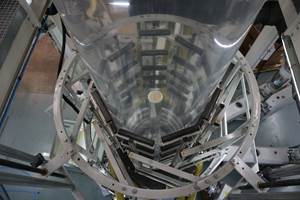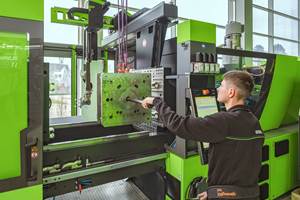10 Keys to the Future of Blow Molding
From customer support and training to process simulation and impact of Industry 4.0—a blow molding machine supplier offers its take on where blow molding is headed.
At a September open house presented by Kautex Machines, Inc. at its North Branch, N.J., headquarters, Chuck Flammer, v.p. of sales, offered his 10-point look ahead at “The Future of Blow Molding” from the point of view of a machine supplier. Here’s a condensation of his main points:
1. Increased customer support: This is necessitated by ongoing trends toward reduced maintenance staffs and shortages of highly trained personnel among blow molders. Machine builders have compensated partly by making control systems more intuitive—but also more complex. One thing they have lacked to date is automated process-optimization routines.
2. Increased customer training: Molders and their OEM customers need to get new products to market faster, and they need to make better use of processing equipment—such as decreased cycle times and lightweighting where possible. Kautex is answering this need with its recently developed Virtual Training tool, a process simulator that mimics exactly the look and behavior of actual machine controls, and shows the effects of control commands on a 3D simulation of the machine. This simulation includes a “transparent” mold presentation where users can see internal details like the blowing needles coming into position.
3. More process simulation: Although there is already limited use of computer simulation of the blowing process to predict wall thicknesses throughout complex-shaped industrial parts such as fuel tanks (see May ’17 cover story on large multi-layer blow molder Agri-Industrial Plastics), Flammer foresees this technique being applied even to bottles in the future. He noted that students at the Institute for Plastics Processing (IKV) in Aachen, Germany, have conducted research on simulating the effects of the PWDS flexible die in decreasing cycle time and part weight. Flammer said this work is “95% accurate in predicting wall thickness and cycle times.” He noted that Kautex Maschinenbau GmbH in Germany does 10 to 20 simulation projects a year using the IKV software.
4. More prototyping: “3D-printed models are great, but they don’t beat the real thing,” says Flammer. That’s why Kautex’s German lab uses 3D-printed models to design and CNC machine metal molds so that real blow molded parts—for small shapes like bottles—can be produced in 48 hr. “Our German lab can produce up to 10,000 production-quality samples,” Flammer states.
5. Machine upgrades and retrofitting: Upgrading an older machine with new hydraulics and mechanical components “will only restore it to its original condition, not bring it up to today’s standards,” says Flammer. To make an older machine more competitive requires retrofitting new controls and sensors and adding new technology, such as robotics and reverse-flushing capability.
6. Increased uptime: Processors today are looking for faster changeovers, especially with higher-cavitation molds, so that one machine can do the work of two or three. This will require more standardization of molds, blow pins, and other tooling. Flammer made an analogy to an Indy 500 Formula 1 race-car pit stop: In 1950, a 1-minute tire change was considered fast. Nowadays, it’s under 2 seconds.The long-term goal for blow molding is automatic machine changeovers. And there’s more to be done than faster mold changes: Faster color changes are another target, which will require work on head design and perhaps wider adoption of technologies like liquid colors. An entirely different aspect of improving uptime is preventing and solving machine or process problems sooner and faster. Solutions will involve “more targeted alarm codes, more sensors, more data,” Flammer predicts.
7. Closer integration with auxiliary suppliers: Examples include integration of inline quality inspection systems, such as vision systems from Intravis, Norcross, Ga., which were discussed at the open house. Integration of such systems, along with color feeders from suppliers like Maguire Products or sister company Riverdale Global, both of Aston, Pa., and both presenting talks at the open house, could provide opportunities for automatic adjustment of colorant ratio, as well as parison thickness. In Flammer’s opinion, the blow molding machinery OEM is best situated to oversee such integration and minimize failures between different systems.
8. Emergence of Industry 4.0: “Collaboration of machinery in the internet age” is the next biggest trend, according to Flammer. Sensors on the molding press, and on upstream and downstream auxiliaries, along with a global-standard communication interface, will allow connected devices to “talk” to each other. Add in custom algorithms to use machine data to make decisions, and lights-out production becomes an everyday possibility. Flammer notes that Kautex is currently working on its first Industry 4.0 project for a U.S. packaging customer. It will requie adding more sensors to the equipment, among other things.
9. More innovation: Technology suppliers will need to listen closely to customers to anticipate their needs, Flammer says. Achieving cost reductions through multilayer structures is one example—using colorants or special additives only in outside layers; or incorporating recyclate in inner layers where it does not affect product appearance; or using foamed inner layers for weight and material savings—again without compromising surface finish. Another example is penetrating new markets with lightweight, high-strength composites. For instance, Kautex in Germany is investigating complete lines for blow molding liners for high-pressure gas cylinders to power hydrogen-fueled cars, and then overwrapping the liners with filament-wound composite. And there is continuing pressure for greater automation and self-regulation. One European customer, notes Flammer, operates 36 blow molders with just six persons per shift—and wants to cut that crew to five. Equipment suppliers will also need to work on accommodating new materials, such as extrusion-grade PET for clear handleware that could replace PVC and PC with a more easily recyclable alternative.
10. More investment: To keep up with growing demand and shorter product cycles, equipment suppliers must invest in new facilities, says Flammer, to shorten lead times. He cites the example of the new assembly hall that Kautex in Germany started up at the end of September. It will be able to supplier multilayer fuel-tank machines in eight months instead of 12. Investment in people, says Flammer, is just as important—particularly investment in young people. “The new work force is different from the old one,” he notes, “and we need to take ideas from everyone.” The average age of Kautex employees has dropped from 46-47 to less than 41 over the last decade. And while Kautex in North America has hired more service people (now totaling 11), it uses them more productively with its new remote service program.
Related Content
TAPPI to Provide Film Education Program at PTXPO 2023
Second-ever PTXPO will feature a robust education program on flexible film, with more technical programming in the works.
Read MoreMold-Change Time Targeted with Training, Technology
Engel is offering technology and training to molders to help them optimize their mold-changing process.
Read MoreGraduate Students Simulate Packaging Designs with Development Software
Software from Nova used in packaging engineering course.
Read MoreAsaclean Launches Interactive, Educational Website
Offering nearly 500 pages of purging content in English & Spanish, the new site is suited to both new and experienced processors.
Read MoreRead Next
People 4.0 – How to Get Buy-In from Your Staff for Industry 4.0 Systems
Implementing a production monitoring system as the foundation of a ‘smart factory’ is about integrating people with new technology as much as it is about integrating machines and computers. Here are tips from a company that has gone through the process.
Read MoreUnderstanding Melting in Single-Screw Extruders
You can better visualize the melting process by “flipping” the observation point so that the barrel appears to be turning clockwise around a stationary screw.
Read More




























